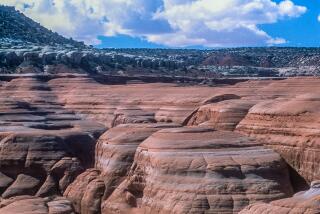Digging for Dinosaurs on the Plains of Montana
- Share via
“Please move over a little,” the paleontologist urged as the midday sun beat on my head. “You’re sitting on a dinosaur bone.”
I thought I felt something sharp, there on the scrabbly plains of western Montana.
The edge of the femur had just been unearthed in a rich dinosaur dig between Choteau, a county seat of 1,700 residents, and the east front of the Rocky Mountains. Scientists from the Museum of the Rockies in Bozeman work there each summer in a vast prehistoric bone pile at the end of a rough gravel road.
Dave Swingle, the sunburned educator who asked me to move, claims that more has been learned about dinosaur behavior in that two-square-mile site than “in all the rest of the world put together.” Since 1978, they have found herds of dinosaur skeletons, bones of juveniles and nests of fossilized eggs--so many that the place is dubbed “Egg Mountain.”
The human star of the dig--the compelling personality who attracts the funds and excitement and volunteers--is the maverick Jack Horner, a black-bearded Montanan who flunked out of college but went on to teach vertebrate paleontology at Princeton before returning to dig for bones in his home state.
More Indiana Jones than Ivory Tower, Horner has walked this crumpled land for years, keen eyes scanning the rocky ridges for glints of eggshells or stubs of bone or geologic rifts that could bring clues to the dinosaur world. “I don’t give a damn how they died,” he has said. “I want to know how they lived.”
For his zeal and imagination, Horner received a MacArthur Foundation “genius” grant. Last autumn, he brought his blue jeans-and-denim message to television in the acclaimed series “Dinosaur!,” which debuted in September, 1991 on the Arts & Entertainment Network.
But Horner was away when I visited in September, the day that the camp was closing for the winter. Only the cook and a handful of diggers were left when our truck arrived.
From a distance, the site looks both unreal and strangely familiar: 24 stark, white tepees stab at the turquoise sky. There are no trees, no ranch houses, nothing else to break the wild, ragged line of plains and mountains.
“The tepees were made in Missoula,” Dave Swingle explained. “It’s the same company that made the tepees for the film ‘Dances With Wolves.”’
Each summer, both professionals and amateurs sign up to stay in the tepee village and work at the excavation. “Some--like Jack Horner--have had dinosaur fantasies since they were kids,” Swingle said. “We also have schoolteachers who want to perfect their skills, and college students intrigued by paleontology.”
I watched a Japanese student, in a University of South Carolina T-shirt, as he used a toothbrush to clear the dirt from a dinosaur rib.
“Doesn’t it get boring?” asked a visitor from New York. The student looked up in amazement and then merely smiled and shook his head.
When I asked a Ph.D. candidate from Belfast what brought him to Montana, he replied swiftly: “We don’t have dinosaurs in Ireland.”
This dogged search for prehistoric bones is done with mundane tools: picks, shovels, plastic buckets, metal dustpans, blue tarps, paintbrushes and paper towels, which are soaked in water and placed over the bones before a white plaster cast is applied.
The tepee dwellers share an open-sided cook tent and pavilion, with much-welcome casks of lemonade, water and coffee. Dehydration is an enemy in this arid world. Water must be hauled in and garbage hauled out. Two portable toilets are at mid-camp. Every other day or so, the volunteers ride the camp bus into Choteau for hot showers at a KOA campground.
Most of the tepees are 12 feet in diameter. The largest is 40 feet tall and serves as an auditorium. I opened a flap door and stepped inside to find it surprisingly cool and bright, with work tables that seat 50 people. Shelves hold skulls and bones.
“It’s 45 feet to the top of the lodge poles,” Swingle said. “I’m told it’s the world’s largest cloth tepee. We added more poles than usual for steadiness in this wind. There’s no shelter on the plateau, and when it blows we have to hang on. We made it safe for 60-mile-an-hour winds.”
After supper, the lectures shift from paleontology to astronomy. The fabled Big Sky of Montana turns into a black velvet hole on a summer night, a hole full of silver stars. Planets are probed. Indian legends are shared.
A favorite outing is to the Pine Butte grizzly preserve, established by the Nature Conservancy in a wooded fen to the north. Locals say that more than 40 grizzlies trundle out of the Rockies after their hibernation to forage for rose hips and chokecherries amid the greenery near the Teton River. Yes, they are vegetarians.
The road to the dig is maintained by the Air Force, since bones are not the only large items lurking under this land. Nuclear warhead missiles are buried not far away from the dinosaur herd.
“Imagine the aerial photos,” Swingle said with wonder. “Imagine what Russian intelligence would make of discovering nuclear missile sites and white tepees in the same satellite picture.”
Four weeklong field study sessions are offered at the dinosaur dig in Montana for the summer of 1992: July 12-18, 19-25; July 26-Aug. 1; Aug. 2-8. Costs: $900 for adults, $700 for children. Includes everything except sleeping bags. Minimum age is 10, with accompanying adult; otherwise 15. For more information, contact the Museum of the Rockies, Montana State University, Bozeman, Mont. 59717, (406) 994-5257.
More to Read
Sign up for Essential California
The most important California stories and recommendations in your inbox every morning.
You may occasionally receive promotional content from the Los Angeles Times.













